Economics 4139 Guías de estudio, Notas de estudios & Resúmenes
¿Buscas las mejores guías de estudio, notas de estudio y resúmenes para Economics 4139? En esta página encontrarás 5 documentos de estudio para Economics 4139.
All 5 resultados
Ordenador por
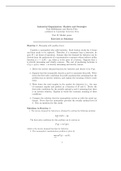
-
Exercises and solutions - Part II|Industrial Organization: Markets and Strategies
- Examen • 27 páginas • 2022
-
- $10.49
- 1x vendido
- + aprende más y mejor
Industrial Organization: Markets and Strategies Exercises & Solutions Exercise 1 Monopoly with quality choice Consider a monopolist who sells batteries. Each battery works for h hours and then needs to be replaced. Therefore, if a consumer buys q batteries, he gets H = qh hours of operation. Assume that the demand for batteries can be derived from the preferences of a representative consumer whose indirect utility function is v = u(H) pq, where p is the price of a battery. Suppose that u ...
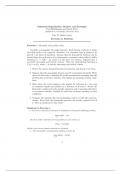
-
Industrial Organization: Markets and Strategies Paul Belleáamme and Martin Peitz published by Cambridge University Press Part II. Market power Exercises & Solutions
- Otro • 27 páginas • 2023
- Disponible en paquete
-
- $10.49
- + aprende más y mejor
Consider a monopolist who sells batteries. Each battery works for h hours and then needs to be replaced. Therefore, if a consumer buys q batteries, he gets H = qh hours of operation. Assume that the demand for batteries can be derived from the preferences of a representative consumer whose indirect utility function is v = u(H) pq, where p is the price of a battery. Suppose that u is strictly increasing and strictly concave. The cost of producing batteries is C(q) = qc(h), where c is stric...
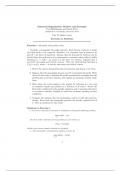
-
Industrial Organization: Markets and Strategies Paul Belleáamme and Martin Peitz published by Cambridge University Press Part II. Market power Exercises & Solutions
- Otro • 27 páginas • 2023
- Disponible en paquete
-
- $14.49
- + aprende más y mejor
Exercise 1 Monopoly with quality choice Consider a monopolist who sells batteries. Each battery works for h hours and then needs to be replaced. Therefore, if a consumer buys q batteries, he gets H = qh hours of operation. Assume that the demand for batteries can be derived from the preferences of a representative consumer whose indirect utility function is v = u(H) pq, where p is the price of a battery. Suppose that u is strictly increasing and strictly concave. The cost of producing bat...
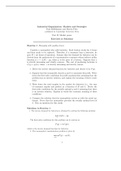
-
Exercises and solutions - Part II Industrial Organization: Markets and Strategies
- Examen • 27 páginas • 2022
-
- $10.49
- + aprende más y mejor
Part II. Market power Exercises & Solutions Exercise 1 Monopoly with quality choice Consider a monopolist who sells batteries. Each battery works for h hours and then needs to be replaced. Therefore, if a consumer buys q batteries, he gets H = qh hours of operation. Assume that the demand for batteries can be derived from the preferences of a representative consumer whose indirect utility function is v = u(H) pq, where p is the price of a battery. Suppose that u is strictly increasing a...
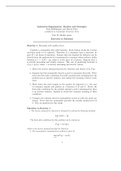
-
Industrial Organization: Markets and Strategies Paul Belleáamme and Martin Peitz published by Cambridge University Press Part II. Market power
- Examen • 27 páginas • 2022
-
- $11.49
- + aprende más y mejor
Consider a monopolist who sells batteries. Each battery works for h hours and then needs to be replaced. Therefore, if a consumer buys q batteries, he gets H = qh hours of operation. Assume that the demand for batteries can be derived from the preferences of a representative consumer whose indirect utility function is v = u(H) pq, where p is the price of a battery. Suppose that u is strictly increasing and strictly concave. The cost of producing batteries is C(q) = qc(h), where c is stric...



